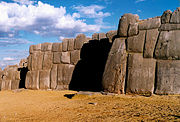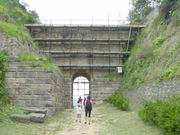Сухая кладка: различия между версиями
| [отпатрулированная версия] | [отпатрулированная версия] |
← Новая страница: «{Subst:L}} thumb|250px|Seventeenth century dry stone wall at [[Muchalls Castle, Scotland]] [[Файл:In…» |
Нет описания правки |
||
| Строка 1: | Строка 1: | ||
{{редактирую|1=[[User:Dmitri Lytov|Dmitri Lytov]]|2=15:25, 11 апреля 2009 (UTC)}} |
|||
{Subst:L}} |
|||
[[Файл:Muchallscastledrystone.jpg|thumb|250px|Seventeenth century dry stone wall at [[Muchalls Castle]], [[Scotland]]]] |
[[Файл:Muchallscastledrystone.jpg|thumb|250px|right|Seventeenth century dry stone wall at [[Muchalls Castle]], [[Scotland]]]] |
||
[[Файл:Inka mauern cuzco.jpg|thumb|250px|right|[[Inca architecture|Inca wall]] of dry stone construction in [[Cusco]], [[Peru]]]] |
[[Файл:Inka mauern cuzco.jpg|thumb|250px|right|[[Inca architecture|Inca wall]] of dry stone construction in [[Cusco]], [[Peru]]]] |
||
[[Файл:Machupicchu intihuatana.JPG|thumb| |
[[Файл:Machupicchu intihuatana.JPG|thumb|250px|right|Intihuatana ritual buildings of dry stone at [[Machu Picchu]], [[Peru]]]] |
||
[[Файл:Mycenae lion gate dsc06382.jpg|thumb|right|The Lion Gate of the [[Mycenae]] acropolis is dry stone]] |
[[Файл:Mycenae lion gate dsc06382.jpg|thumb|250px|right|The Lion Gate of the [[Mycenae]] acropolis is dry stone]] |
||
'''Сухая кладка''' |
'''Сухая кладка''' — is a building method by which structures are constructed from [[Rock (geology)|stones]] without any [[Mortar (masonry)|mortar]] to bind them together. Dry stone structures are stable because of their unique construction method, which is characterized by the presence of a [[Structural load|load-bearing]] facade of carefully-selected interlocking stones. Dry-stone technology is best known as wall construction, but dry stone [[building]]s, [[bridge]]s, and other structures also exist. |
||
Some dry-stone wall constructions in north-west Europe have been dated back to the Neolithic Age. Many Cornish hedges are believed to date from [[4000 B.C.]], although there appears to be little dating evidence. In County Mayo, Ireland, an entire field system made from dry-stone walls, since covered in peat, have been carbon-dated to 3800 B.C. The [[cyclopean]] walls of the [[acropolis]] of [[Mycenae]] have been dated to 1350 B.C. and those of [[Tiryns]] slightly earlier. In [[Belize]], the [[Maya civilization|Mayan]] [[ruins]] at [[Lubaantun]] illustrate use of dry stone construction in architecture of the eighth and ninth century AD. |
Some dry-stone wall constructions in north-west Europe have been dated back to the Neolithic Age. Many Cornish hedges are believed to date from [[4000 B.C.]], although there appears to be little dating evidence. In County Mayo, Ireland, an entire field system made from dry-stone walls, since covered in peat, have been carbon-dated to 3800 B.C. The [[cyclopean]] walls of the [[acropolis]] of [[Mycenae]] have been dated to 1350 B.C. and those of [[Tiryns]] slightly earlier. In [[Belize]], the [[Maya civilization|Mayan]] [[ruins]] at [[Lubaantun]] illustrate use of dry stone construction in architecture of the eighth and ninth century AD. |
||
Версия от 15:25, 11 апреля 2009
Эту страницу в данный момент активно редактирует участник Dmitri Lytov. |
[[Категория:Википедия:Ошибка выражения: неожидаемый оператор <, редактируемые прямо сейчас]]




Сухая кладка — is a building method by which structures are constructed from stones without any mortar to bind them together. Dry stone structures are stable because of their unique construction method, which is characterized by the presence of a load-bearing facade of carefully-selected interlocking stones. Dry-stone technology is best known as wall construction, but dry stone buildings, bridges, and other structures also exist.
Some dry-stone wall constructions in north-west Europe have been dated back to the Neolithic Age. Many Cornish hedges are believed to date from 4000 B.C., although there appears to be little dating evidence. In County Mayo, Ireland, an entire field system made from dry-stone walls, since covered in peat, have been carbon-dated to 3800 B.C. The cyclopean walls of the acropolis of Mycenae have been dated to 1350 B.C. and those of Tiryns slightly earlier. In Belize, the Mayan ruins at Lubaantun illustrate use of dry stone construction in architecture of the eighth and ninth century AD.
Примечания
Литература
- Murray-Wooley, Carolyn and Karl Raitz. Rock Fences of the Bluegrass, University Press of Kentucky. 1992.
- Francis Pryor, Britain BC, Harper Perennial. 2003.
- Colonel F. Rainsford-Hannay, Dry Stone Walling, Faber & Faber. 1957
Галерея
-
Dry stone wall with window in Bignasco, Switzerland (Swiss-Italian part)
-
Detail of a dry stone wall in the Yorkshire Dales
-
Adding dry stone wall to convert the space under the large rock into the functional building near Bignasco, Switzerland
-
Inca wall of dry stone at Machu Picchu, Peru
-
A rock fence
-
The dry stone arch, so called Porta Rosa (half of the IV Century b.C.), in Elea, Magna Graecia
См. также
Ссылки
- Dry Stone Walling Association of Canada
- Dry Stone Walls Association of Australia
- Dry Stone Walling Association of Great Britain
- The Guild of Cornish Hedgers
- British Trust for Conservation Volunteers skills page on dyking
- BTCV dry stone walling book
- Current Archaeology notes on Working Holidays repairing dry stone walls
- Dry Stone Conservancy, dedicated to preserving and promoting dry stone masonry
- Stone-Line, Group of the Swiss dry stone masons
- SVTSM, Association of the professional Swiss dry stone masons
- Umwelteinsatz, Drystone activity of the Swiss Foundation for Environmental Action
- The Character of a Wall. The changing construction of agricultural (dry stone) walls on the island of Gozo, Malta Article by Adam Thompson based on anthropological field research. Omertaa, Journal for Applied Anthropology (www.xpeditions.eu)










